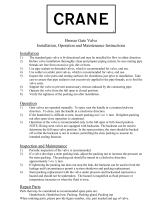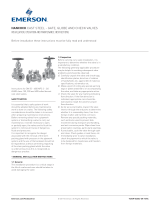TESCOM Primary Root Valves O&SI User guide
- Type
- User guide
TESCOM Primary Root Valves O&SI are designed to provide reliable isolation of process fluids in critical applications. Precision-machined components and a robust design ensure leak-tight performance and long service life. These valves are ideal for use in oil and gas, chemical processing, and other industrial applications where safety and reliability are paramount. With a variety of sizes, materials, and configurations available, TESCOM Primary Root Valves O&SI can be customized to meet the specific requirements of your application.
TESCOM Primary Root Valves O&SI are designed to provide reliable isolation of process fluids in critical applications. Precision-machined components and a robust design ensure leak-tight performance and long service life. These valves are ideal for use in oil and gas, chemical processing, and other industrial applications where safety and reliability are paramount. With a variety of sizes, materials, and configurations available, TESCOM Primary Root Valves O&SI can be customized to meet the specific requirements of your application.



-
 1
1
-
 2
2
-
 3
3
TESCOM Primary Root Valves O&SI User guide
- Type
- User guide
TESCOM Primary Root Valves O&SI are designed to provide reliable isolation of process fluids in critical applications. Precision-machined components and a robust design ensure leak-tight performance and long service life. These valves are ideal for use in oil and gas, chemical processing, and other industrial applications where safety and reliability are paramount. With a variety of sizes, materials, and configurations available, TESCOM Primary Root Valves O&SI can be customized to meet the specific requirements of your application.
Ask a question and I''ll find the answer in the document
Finding information in a document is now easier with AI
Related papers
Other documents
-
 Crane Valve/Crane Energy Flow Sol 431UB*004 Installation guide
Crane Valve/Crane Energy Flow Sol 431UB*004 Installation guide
-
Keystone Model FC Check Valves O&SI Owner's manual
-
Cash Valve 2300 Series Valve Shut-Off Installation guide
-
Cash Valve Type C776 Pressure Relief Valves for Cryogenic Owner's manual
-
Apollo Conbraco 77CLF20801 Installation guide
-
Cash Valve Shut-off valve 2300 series short stem IOM Owner's manual
-
 Hancock Cast Steel Gate, Globe and Check Valves IOM Owner's manual
Hancock Cast Steel Gate, Globe and Check Valves IOM Owner's manual
-
KTM 2-way, 3-way and V-port ball valves Owner's manual
-
Anderson Greenwood Pilot Operated SRV Series 5200 - IOM Owner's manual
-
Apollo Saturn Series Installation, Operation and Maintenance Manual




